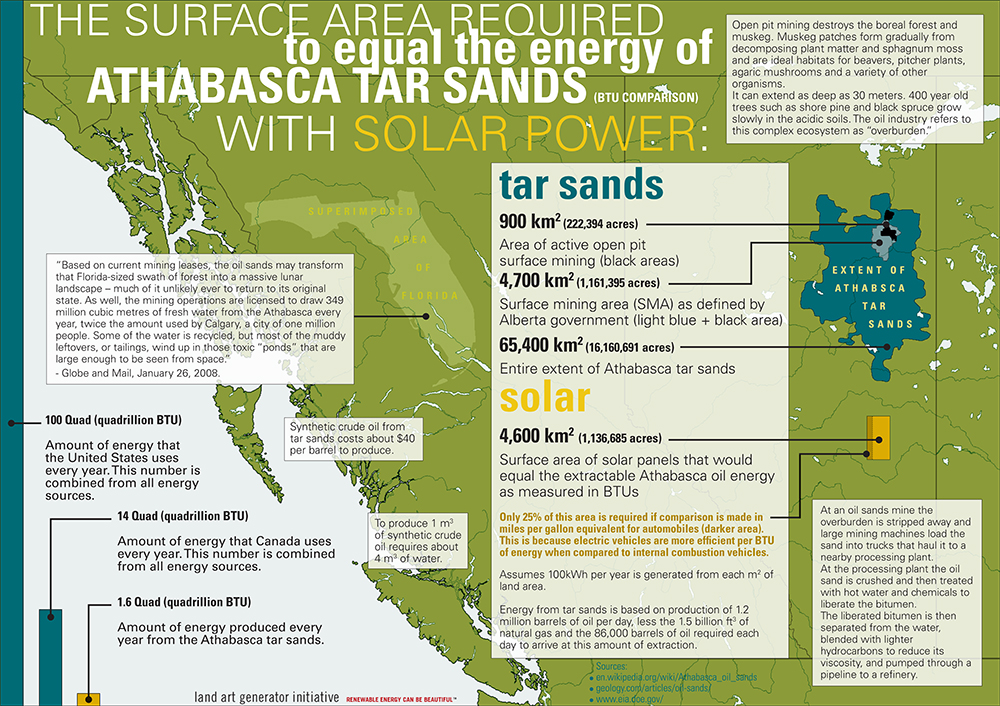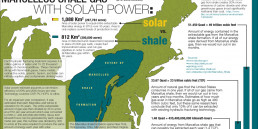[Updated on June 4, 2015 to give a better number for solar production capacity per m2 area]

This graphic shows how much surface area would be required to replace all of the BTUs of energy that can be extracted annually from the Athabasca tar sands in Alberta, Canada. The process of mining the bitumen-rich sand is severely and irreversibly damaging to the environment. The surface mining operations (the more economically viable method) require the removal of 20 feet of “overburden” (the industry term for the delicate ecosystem of boreal forest and muskeg) and the further removal of potentially 100 feet of subsoil, parts of which contain the tar sands.
 More information about Athabasca tar sands and the environmental effects of the mining can be read here (use the zoom feature on the photos), and here, and some really amazing aerial photographs of the destruction (by Louis Helbig) can be seen here.
More information about Athabasca tar sands and the environmental effects of the mining can be read here (use the zoom feature on the photos), and here, and some really amazing aerial photographs of the destruction (by Louis Helbig) can be seen here.
The amount of effort that it takes to literally scrape away 100 feet of earth over thousands of acres makes this the most ambitious earth moving project in human history. And that doesn’t even begin to take into consideration the separation of the sulfur content and other refinement processes, the management of massive fluid impoundment areas, and the logistics of shipping, piping and transportation. It makes us wonder if all of that human energy went into the production of concentrated solar power plants, how many could we bring on line in ten years?
 Photo on the left is undisturbed Boreal forest. The photo on the right is taken from National Geographic.
Photo on the left is undisturbed Boreal forest. The photo on the right is taken from National Geographic.
 There is one thing yet missing from this comparison though. If what we are talking about here is a direct comparison between synthetic crude oil and solar generated electricity, then we need to look at one of the primary end uses of these forms of energy: transportation.
There is one thing yet missing from this comparison though. If what we are talking about here is a direct comparison between synthetic crude oil and solar generated electricity, then we need to look at one of the primary end uses of these forms of energy: transportation.
We shouldn’t really compare BTU for BTU between these two sources of transportation fuel because the end-use efficiencies differ so much. In other words, you can get a lot further on every BTU of energy in an electric car than you can on each BTU of energy in a car with an internal combustion engine. In fact, you can get four times as far! A look at the Nissan Leaf shows that is uses 0.34KWh of energy for every mile that it travels. This is equivalent to 1,160 BTUs. The average fuel economy of cars in America is 19.8 miles per gallon. Let’s be generous and use a figure of 25 miles per gallon. That is the same as saying that the car uses 0.04 gallons every mile (1/25), which is equivalent to 4,564 BTUs. So you can reduce the surface area required by 1/4 (the darker yellow on the graphic) and you will have a more accurate comparison for replacing transportation fuels.
Given that the tar sands tailings ponds (storage of toxic byproduct water) alone already cover 150 square kilometers, it makes the comparison very enlightening that with not that much more area we could accomplish the same result with no emissions and with an eternally renewable energy source. Perhaps we should start by placing solar panels over the tailing ponds?
The solar power required to replace all of the BTUs of energy contained within the tar sands is significant. There is a lot of energy buried under those forests. But just because the energy is there doesn’t necessarily mean that we have to dig it up. Especially when there are other options that are clearly available to us. They may be more challenging to accomplish and they may require public investment, but doing the right thing should make the effort worthwhile. Otherwise we have decided that it is OK to destroy tens of thousands of kilometers of forest and habitat, and at the same time add hundreds of thousands of tons of CO2 into an atmosphere that is already way past its limit. It is up to us to conserve energy and to create it sustainably. We’ve designed and built more than one 100MW solar power plant before. We can do it if we have the will.

